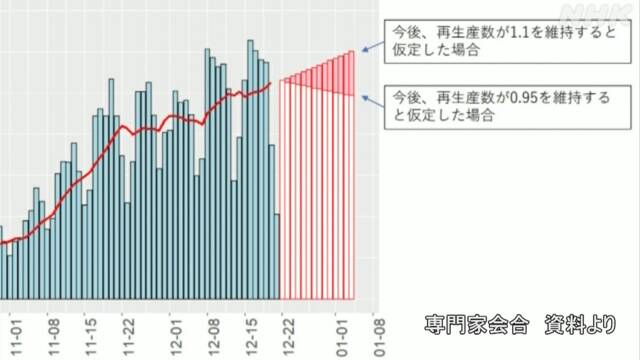Motoi Suzuki, Director of the Epidemiology Center for Infectious Diseases, National Institute of Infectious Diseases, has released a simulation of how the number of newly infected people nationwide may change in the future.
In the simulation, based on a number called "effective reproduction number" that shows how many people are infected from one infected person, how the change in this number will affect the number of infected people after 21st of this month. I calculated.
The "effective reproduction number" is announced as 1.06 nationwide as of the 6th of this month.
According to NHK's summary, as of the 21st of this month, the average number of newly infected people nationwide in the last week was about 2,700 per day.
According to the simulation, if the number of remanufactured products is 1.1 after this, the average number of new infections per day will increase to about 3000 on the 4th of next month, two weeks later.
On the other hand, assuming that the number of reproductions has dropped to 0.95, the number of new infections per day will be about 2,500 on the 4th of next month.
Simulations have shown that if the effective reproduction number declines, there will be a difference of about 500 people per day on January 4, next year, but the number of infected people may continue to be high.
Suzuki said, "Even if the effective reproduction number is 1.1 or 0.95, it turns out that there are about 3000 to 2500 newly infected people every day. Then, the medical field becomes even more tight and more serious. It is not enough to reduce the effective reproduction number to less than 1, and it must continue to be reduced. It is difficult to converge unless each person makes every effort to prevent the expansion from this moment. Isn't it? "
Calculate "effective reproduction number" Expansion trend in Tokyo
Under the supervision of Director Motoi Suzuki, NHK calculated the "effective reproduction number", which indicates how many people one infected person will spread.
In order to obtain the effective reproduction number more accurately, it is necessary to consider more conditions such as estimating and calculating the onset date, and it takes time to obtain the value, so this time, the latest value It is calculated by a simple method based on the number of infected people per day confirmed as a guideline.
As a result, the number of effective reproductions nationwide as of the 23rd was 1.04.
As for the effective reproduction number,
it is said that the
infection tends to
spread when it exceeds ▽ "1", while it
tends to
converge when it falls below ▽ "1", and the
infection still tends to spread nationwide. I understand.
Also, if you calculate using the same method for Tokyo and Osaka prefectures, which have many infected people, and Aichi prefecture and Hokkaido, the effective reproduction number as of the 23rd
is 1.14 in Tokyo, and the infection continues to spread. It was.
On the other hand,
▽ Aichi prefecture was 0.98,
▽ Osaka prefecture was 0.88, and
▽ Hokkaido was 0.84,
all of which were below 1.
Regarding this, Director Suzuki said, "It is highly likely that this tendency will continue in Tokyo at least within the year. If the spread continues in Tokyo, the infection will spread to the surrounding areas, so people in the metropolitan area including Tokyo will be especially from now on. I want you to be careful and act. On the other hand, in Hokkaido, Osaka, Aichi, etc., it is below 1, and it seems that awareness of countermeasures and prevention is beginning to appear in the numerical value. However, even in areas below 1, a little There is a risk that the figures will return again if we are not careful, so we need to be patient and continue to take measures. "

